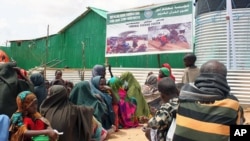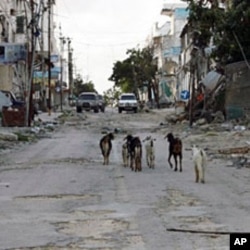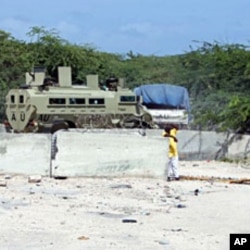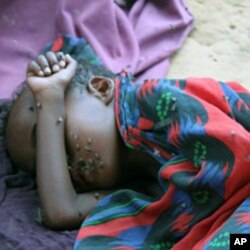The al-Qaida-linked extremist group al-Shabab may have been driven out of Somalia's capital, Mogadishu this month, but its lingering influence remains a significant obstacle to aid delivery efforts. Humanitarian groups are trying to devise strategies to get food and medicine to Somalia’s famine-stricken population.
Mogadishu’s main commercial district, Bakara Market lies in ruins. Only a few armed guards and stray animals wander its streets.
The desolation is mute testimony to the weeks of house-to-house combat that took place before African Union troops broke al-Shabab’s stranglehold on Somalia’s capital.
An estimated 3,000 Shabab fighters fled the city August 5, heading for safety in the mostly rural southern regions they still control.
The Shabab retreat had raised hopes that a massive humanitarian exercise might be launched to save millions of people said to be near death in Somalia’s famine-hit south.
But Lieutenant Colonel Paddy Ankunda, spokesman for the African Union AMISOM peacekeeping force, cautions that the Shabab remains a dangerous force, capable of switching to guerrilla tactics and terrorist strikes.
"Al-Shabab is out of the picture for the moment, but they still have capacity to cause havoc in terms of their ability to mobilize improvised explosives, in terms of their ability to use roadside bombs, in terms of their ability to assassinate people," said Ankunda. "So they’re simply out of the visible front lines, but I think we’re going to see more of these attacks."
Efforts to mount a humanitarian campaign have also been hamstrung by the absence of an aid delivery system. Years of al-Shabab violence and intimidation have prompted the United Nations and humanitarian agencies to close down their Somalia operations.
Now, with famine gripping the land and thousands of people arriving in the capital daily in desperate condition, precious time is being lost as the aid community tries to reorganize.
The international NGO Mercy Corps is among agencies that have kept a minimal presence in Somalia through the dark years. Mercy Corps representative Cassandra Nelson is in Mogadishu to see about getting an emergency famine-relief program going quickly.
But she says potential local partners remain leery of joining the effort for fear they might be targets if al-Shabab should return.
"It’s not just the humanitarian community that’s concerned," said Nelson. "It’s really the people on the ground here, the civilian community that are concerned because they’re really the ones caught in the middle of everything, and if al-Shabab were to come back, they could face a lot of problems if they’re found on the wrong side of the coin."
Nelson has worked in hostile environments before, from Afghanistan to Iraq and other conflict areas. But she says Somalia is the most challenging environment she’s seen, requiring a full-scale international humanitarian response.
"It’s easy to feel overwhelmed. There’s over 1.5 million displaced people in southern Somalia, about a half million in Mogadishu," Nelson added. "There’s certainly no way Mercy Corps or any other agency can assist them all. It is going to need all hands on deck to assist these people sufficiently because the needs are tremendous and the reality is, this is not a short-term crisis. Regardless of how great the response is, it’s the fact this is a famine and a long-term crisis."
Frustrated officials admit it will likely be many weeks or months until a famine-relief system is up and running, time when uncounted thousands of people will starve to death.
They say even in retreat, the few thousand al-Shabab fighters are proving to be a powerful deterrent to international agencies hoping to mount a humanitarian rescue operation in Somalia.














